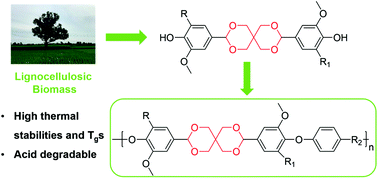Degradability, thermal stability, and high thermal properties in spiro polycycloacetals partially derived from lignin†
Abstract
A series of partially bio-based spiro polycycloacetals was synthesized using lignin-based feedstocks, vanillin and its derivative syringaldehyde, along with pentaerythritol and commercially available co-monomers including 4,4′-difluorobenzophenone (DFP) and bis(4-fluorophenyl) sulfone (DFS). These spiro polycycloacetals displayed high thermal stabilities (degradation temperatures in the range of 343–370 °C, as quantified by 5% mass loss) and high glass transition temperatures (in the range of 179–243 °C). While DFS-containing polymers were amorphous, DFP-containing polymers were semi-crystalline with high melting temperatures (in the range of 244–262 °C). The hydrolytic degradation behavior of one spiro polycycloacetal, derived from vanillin and DFP, was investigated. Importantly, the spiro polycycloacetal was rapidly degraded to small molecules and oligomeric byproducts under acid-catalyzed conditions. This class of spiro polycycloacetals is therefore an important contributor to the development of more easily degradable polymers which also retain sufficiently high thermal properties and thermal stability.

- This article is part of the themed collection: Sustainable Polymers


 Please wait while we load your content...
Please wait while we load your content...